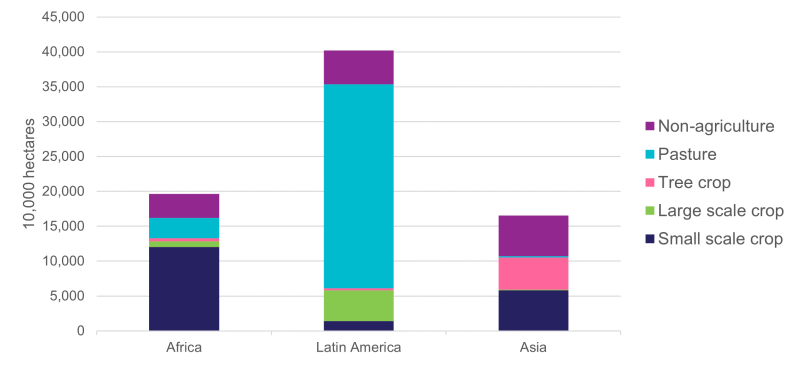7.1.2
Deforestation risk commodities
Land-use change (mainly deforestation) is the second largest source of anthropogenic carbon dioxide emissions, with most of this occurring in tropical regions.[90] As intact habitats are destroyed, carbon previously locked up in biomass is released as greenhouse gases into the atmosphere. Without keeping these habitats intact, it will be extremely difficult to meet climate goals in the Paris Agreement.[91]
In recent years there has been an increasing recognition that the production of many crops and livestock products carries risk of driving land conversion and deforestation. According to research by WWF, approximately 28% of the UK’s overseas land footprint is in countries experiencing high rates of destruction of nature, and with poor track records of labour rights and governance.[92]
This is particularly a challenge for soya crop produced in America, for example in the Cerrado Region of Brazil. According to research commissioned by UK retailers, more than 1.5 million tonnes of soy are used in supply chains – of which only 26% of the soymeal assessed was shown to be sourced from a regions free from deforestation, or to be certified as not contributing to land conversion.[93]
Emissions profile
Each hectare of deforestation can release between 350 and 900 tonnes of carbon dioxide emissions into the atmosphere[94] – and in the tropics it is estimated that some 11.9 million hectares of tree cover were lost in 2019 alone.[95] Historically, deforestation and other forms of land conversion have been driven by agricultural production (see Figure 7.1d below). Globally, tropical forest loss accounts for 8% of the world’s annual carbon dioxide emissions.[96]

Figure 7.1e: Scale and drivers of historic deforestation in Asia, South America, and Africa[97]
Routes to decarbonisation for deforestation risk commodities
Traceability is key to ensuring that deforestation risk commodities are sustainably sourced. Commodity certification and comprehensive purchasing criteria – overseen by independent third parties where possible – can help establish minimum standards that drive responsible sourcing of raw materials. Meaningful relationships with smallholders, whether in direct partnership or facilitated by reputable organisations, can also help to drive sustainable production practices. Ultimately, the elimination of deforestation can only occur when incentives for sustainable production and equitable livelihoods align, and retailers have a major part to play in driving value to the very base of the supply chain in order to facilitate this.
The level of deforestation and uncertainty in the traceability of the soya in the supply chain has led some retailers to take immediate action. In one such move, Lidl UK has committed to sourcing 100% of soya from sustainable sources. The retailer calculated that approximately 130,000 tonnes of soy were linked to their supply chains in 2018/19, primarily as feedstock in meat and dairy production.[98] Lidl will cover this volume using credits from the Roundtable for Responsible Soy, while moving to physically traceable sustainable sources in the long-term.[99]
Within the last twelve months the urgency to address this challenge has grown, as the industry and customer base recognise that substantial action is needed to address the current climate emergency. Companies including Nestle, Mars and Unilever are among the 17 multinational consumer goods firms leading a new corporate coalition dedicated to tackling deforestation, forest degradation and land conversion in supply chains.[100] Launched by the Consumer Goods Forum (CGF), the ‘Forest Positive Coalition of Action’ consists of the chief executive officers of each of the partaking companies and will engage an array of stakeholders across the value chains of key forest-related commodities, from producers and suppliers, to policymakers and consumers. As members of the coalition, these companies are committing to engage with suppliers and traders to roll out ‘forest-positive’ solutions across the value chain of key commodities with forest links.
[90] IPCC 2013 Climate Change 2013: The Physical Science Basis. Contribution of Working Group I to the Fifth Assessment Report of the Intergovernmental Panel on Climate
[91] Maxwell et al., (2019) Degradation and forgone removals increase the carbon impact of intact forest loss by 626%. Sci. Adv. 2019;5
[92] WWF UK (2020) Risky Business
[93] Retail Soy Initiative (2019). 3Keel.
[94] Forestry. In Climate Change 2007: Mitigation. Contribution of Working Group III to the Fourth Assessment Report of the Intergovernmental Panel on Climate Change
[95] Global Forest Watch (2020) Global tree cover loss data 2019
[96] Global Forest Watch
[97] Based on V De Sy et al (2019) Tropical deforestation drivers and associated carbon emission factors derived from remote sensing data. Environ. Res. Lett. 14 094022
[98] Sustainable Sourcing of Soy (2020). Lidl.
[99] The Chain: Lidl UK Announces Sustainable Soy Commitments (2018). Chain Reaction Research.
[100] Consumer goods giants team up to tackle deforestation (Sept 2020) – edie.net